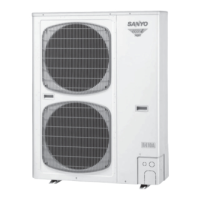Replacement of Main Units
TD831077
VII-14
7
¶ When a ball valve is not installed at the outdoor unit side
The refrigerant inside all indoor units and the pipes between all units must be pumped down to the outdoor unit side. The
pumping down capacity of this outdoor unit is approximately 10 kg in this system. As a result, another refrigerant recov-
ery device is always necessary. Perform cleaning properly by following the procedure below. Fig. C (P21). The outdoor
units are pumped down in the order of (1) AD unit and then (2) PC unit.
1. As shown in the figure, install a pressure gauge (high-pressure, low-pressure) at the outdoor units where the
refrigerant will be pumped down.
2. Fully close the liquid pipe valves of the outdoor units where the refrigerant will be pumped down.
3. Stop the unit when the high-pressure gauge of the unit where the refrigerant is being recovered reaches 2.45 MPa
(25 kg/cm
2
). (All Stop)
* Stopping procedures (two examples)
a) Make an instantaneous short-circuit at the operation stop pin (CN024-2P) on the C.C.U.
b) Pull the temperature thermistor connector unit on the outdoor unit control PCB from the PCB. (Any PCB can be
used as long as it is not a discharge temperature PCB. Never pull by grasping the lead wires.)
4. Immediately fully close the gas pipe valves of the outdoor units where the refrigerant were pumped down.
5. Remove the inter unit wiring between the units of the outdoor PC and AD units where the refrigerant has been
pumped down.
6. Set the AD unit quantity setting DIP switch (S006) on the C.C.U. to the number of outdoor units where the pumping
down of the refrigerant has not been completed.
7. Operate the remaining outdoor units in cooling mode. (Cooling operation is performed also when the lower 2P pin of
the cooling/heating selector pin (CN022-3P) on the C.C.U. is instantaneously short-circuited.)
8. In the next steps, repeat pumping down for each outdoor unit using the procedure described above. When pumping
down for all the outdoor units is completed, prepare the refrigerant recovery device. (Although this varies depending
on the pipe length at the site, approximately 10 to 40 kg of refrigerant is recovered.)
9. Simultaneously recover the refrigerant in the indoor units and in the pipes between units from all of the outdoor unit
liquid pipe and gas pipe valve service ports.
Fully close the valves of the outdoor unit, and leave the indoor and outdoor units in their stopped status. Since the
recovered refrigerant will later be used for charging, do not mix it with other recovered refrigerant.
10. Perform refrigerant recovery operation until the refrigerant recovery device low-pressure switch is activated. (For
information about refrigerant recovery device operation, refer to the operation manual of the respective device.)
11. Release the small amount of residual gas refrigerant into a safe location.
12. As shown in Fig. C (P21), install the liquid pipe ball valve and dry core of the outdoor units. (The size varies accord-
ing to the specific model. This uses the flare connection method.) Open the ball valve. Remove the dry core
mounted to the service pipe.
13. Inspect for leaks in the pipe where the ball valve and dry core are mounted (nitrogen pressure: approx. 1.96 MPa
(20 kg/cm
2
))
14. Make a vacuum inside the indoor unit and unit pipes.
15. Inject the recovered refrigerant into the liquid pipe side. If all of the refrigerant cannot be injected, inject the refriger-
ant into the low-pressure side in gaseous state after operation is started later. Be sure to always inject only the
amount of recovered refrigerant. Also, inject new refrigerant if the refrigerant has a pungent, burning smell.
16. Fully open the liquid pipe valves of all outdoor units. Operate all units.
17. Refer to “(1) When a ball valve is installed at the outdoor unit side” above for the subsequent procedure.
1. Compressors

